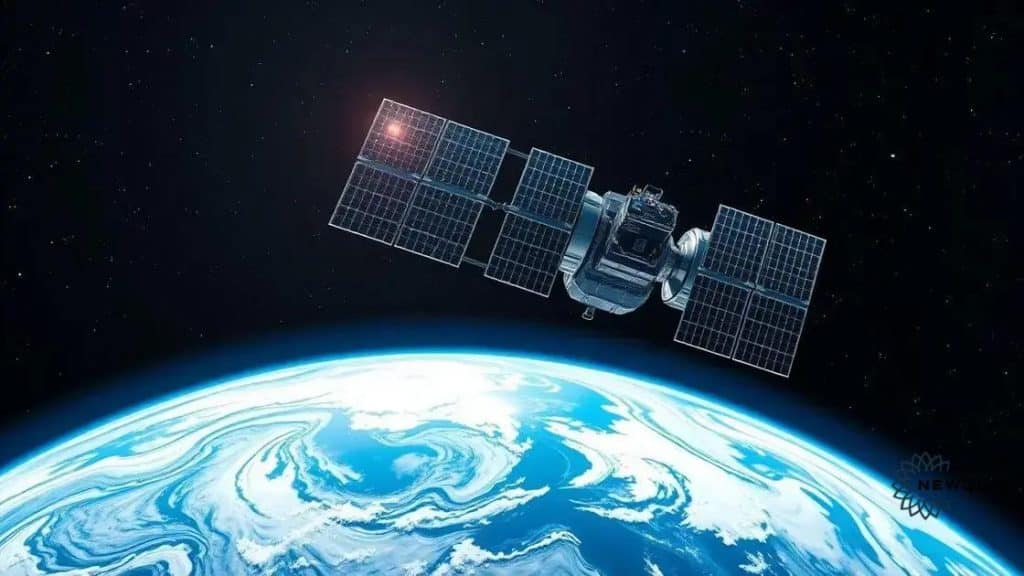Space economy: the next frontier in global economic development

Anúncios
The space economy encompasses all economic activities related to space exploration, driven by innovations, commercialization, and global collaboration, offering significant technological advancements and economic opportunities.
Space economy is rapidly emerging as a key driver of global economic development. With advancements in technology and private investments, the potential for growth is immense. Curious about how this new frontier can shape our future?
Anúncios
Understanding the concept of space economy
Understanding the concept of space economy is essential in today’s rapidly advancing world. The space economy encompasses all economic activities related to space exploration, industries, and services. As we venture beyond our planet, various sectors are transforming to harness the economic potential that lies in the cosmos.
Components of the space economy
The space economy consists of several key components. These elements contribute to creating new opportunities and innovations in various industries.
- Aerospace manufacturing: This involves designing and producing spacecraft, satellites, and launch vehicles.
- Satellite services: These provide communication, weather forecasting, and navigation capabilities.
- Research and development: Investing in innovative technologies to improve space exploration and related industries.
- Tourism: Space tourism is a growing sector, allowing civilians to experience space travel.
Emerging trends highlight the growing importance of collaborations between private companies and government entities. Organizations are recognizing the potential of public-private partnerships in driving forward the space economy. This synergy enables resource sharing, bringing forth fresh ideas and investment, ultimately paving the way for growth. As more businesses enter this burgeoning market, we can expect a significant shift in how we view our connection to space.
Anúncios
The impact on global finance
The rise of the space economy has vital implications for global finance. As countries recognize the potential revenue from space activities, investments are increasing. Governments are allocating more funds to space programs, and private investors see opportunities for profit. This optimistic picture encourages further advancements, ensuring sustainability in this new economic frontier.
Moreover, the space economy has the ability to drive innovation across various sectors. By advancing technology for space applications, we can influence industries such as telecommunications, transportation, and agriculture. These developments may lead to job creation and economic growth far beyond what we can currently imagine.
Key players in the space economy
Key players in the space economy are essential for the development and expansion of this emerging market. Understanding who these players are helps us grasp the intricacies of the space landscape. Various organizations and companies contribute to the vast potential of the space economy, creating opportunities for innovation.
Government agencies
One of the main contributors to the space economy is government agencies. These organizations often lead space missions, research, and development. They also play a crucial role in funding initiatives aimed at exploring space.
- NASA (National Aeronautics and Space Administration): A pioneer in space exploration and technological advancement.
- ESA (European Space Agency): Collaborates with multiple countries to explore space and develop satellite systems.
- ISRO (Indian Space Research Organisation): Known for its cost-effective missions and innovative advancements in satellite technology.
In addition to government agencies, private companies are increasingly impacting the space economy. They are driving innovations and ensuring that space exploration is more accessible.
Private space companies
Emerging private enterprises have gained significant attention recently. These companies are engaged in various activities, from launching satellites to developing technologies for space travel. Their entry into the market has sparked a new wave of investment and innovation.
- SpaceX: Revolutionizing space travel with reusable rockets and plans for Mars colonization.
- Blue Origin: Focusing on making space travel affordable and accessible for commercial use.
- Virgin Galactic: Aiming to promote space tourism for civilians.
The collaboration between these private players and government entities enhances growth opportunities in the space economy. As we witness new partnerships form, sharing resources and expertise facilitates advancements. This interaction enables better exploration techniques and fosters innovation, benefiting various sectors.
Furthermore, universities and research institutions contribute to the development of the space economy. By conducting research and developing new technologies, they lay the groundwork for future advancements. These institutions often partner with government agencies and private companies to bring innovative ideas to life.
Innovative technologies driving growth

Innovative technologies driving growth in the space economy are transforming how we explore and utilize space. These advancements not only enhance current missions but also open new possibilities for economic development. Companies and agencies are leveraging cutting-edge technologies to improve efficiency and achieve remarkable goals.
Revolutionary spacecraft
Recent developments in spacecraft technology are pushing the boundaries of what’s possible. Flights that were once considered too difficult or costly are now a reality, thanks to innovative designs and materials.
- Reusable rockets: Companies like SpaceX have pioneered reusable rocket technology, reducing the cost of space travel significantly.
- Small satellite technology: Advancements in miniaturization allow for smaller, more efficient satellites that are cheaper to launch and operate.
- Autonomous systems: Drones and robotic technologies are now being utilized for missions that require precision and safety.
These revolutionary technologies encourage investment and enable more complex missions. As we progress, these tools allow for better data collection and analysis, crucial for understanding space environments.
Advanced communication systems
Innovations in communication technology also play a vital role in the space economy. These systems support both space missions and improve data transmission back to Earth.
- High-speed internet from satellites: Companies like Starlink aim to provide global internet coverage using networks of satellites.
- Laser communication: Offers faster data transmission compared to traditional radio frequencies, essential for handling large data volumes from space missions.
- Enhanced tracking systems: Improved technology helps keep track of objects in space, benefiting both safety and coordination of launches.
As technologies evolve, they work together to create a more connected and efficient space ecosystem. For instance, with advanced communication systems, scientists can share critical information in real-time, leading to quicker decision-making.
Moreover, innovative technologies in analytics and artificial intelligence are playing a crucial role. These tools can analyze vast amounts of data collected from missions. By using AI, researchers can identify patterns and make predictions that can shape future endeavors in space exploration.
Economic benefits and challenges of space exploration
Eeconomic benefits and challenges of space exploration play a crucial role in understanding the broader impact of the space economy. As humanity ventures into space, we witness both potential gains and obstacles that must be addressed. Exploring these aspects helps us appreciate the complexities involved in pushing boundaries beyond our planet.
Benefits of space exploration
There are numerous economic benefits associated with space exploration. These advantages positively influence various sectors, leading to advancements in technology, job creation, and new markets.
- Technological innovation: Space missions often require cutting-edge technology, which spurs innovation that can be applied in other fields.
- Job creation: The growing space industry leads to new job opportunities in engineering, research, and manufacturing.
- Global collaboration: Countries partnering on space missions foster international relationships and share resources.
Moreover, advancements in technology originally developed for space missions often find applications in everyday life. For instance, satellite technology has drastically improved communication methods, while innovations in materials science lead to stronger and lighter materials used across various industries.
Challenges of space exploration
Despite the many benefits, challenges also exist. Addressing these issues is essential for sustainable growth within the space economy. The key challenges include funding and political support, environmental concerns, and technological limitations.
- Funding: Securing sufficient funding for ambitious space missions can be difficult, necessitating collaboration between public and private sectors.
- Environmental impact: The long-term effects of launching rockets and generating space debris pose challenges to our planet’s ecosystem.
- Technological limitations: Many existing technologies need further development to ensure safety and functionality during space missions.
All these factors contribute to a complex setup in the context of space exploration. Understanding the balance between benefits and challenges will help guide future investments and policies in the space economy.
As we proceed, it is crucial to develop solutions that encompass these challenges while maximizing the economic potential of space exploration. Continued investment, research, and collaboration will lay the foundation for a more robust and sustainable space economy, ready to meet the challenges of tomorrow with innovative solutions.
Future trends in the space economy
Future trends in the space economy indicate exciting possibilities for innovation and growth. As technology evolves and interest in space exploration rises, we can expect significant developments that shape various industries. These trends highlight advancements that will define the next era of the space economy.
Increased commercialization
One major trend is the increased commercialization of space activities. More private companies are entering the market, leading to greater competition and lower costs for launching missions.
- Space tourism: Companies are developing platforms for civilians to travel to space, promoting an entirely new market.
- Satellite constellations: Businesses are launching networks of small satellites to enhance global communication and internet services.
- Mining asteroids: The potential for resource extraction from asteroids is becoming a viable area of exploration.
These developments not only create economic opportunities but also make space more accessible to everyone.
Advancements in technology
Technological innovations will continue to drive growth in the space economy. As research progresses, we see remarkable improvements in various fields.
- Revolutionary propulsion systems: New propulsion technologies will enable faster and more efficient space travel.
- AI and machine learning: These technologies will enhance data analysis and mission planning, improving success rates.
- 3D printing in space: Utilizing 3D printing allows for in-situ resource utilization, decreasing dependency on Earth supplies.
As technologies develop, we can anticipate smoother and more successful missions into space.
Moreover, sustainability will become a vital focus in the space economy. Addressing the issues surrounding space debris and ensuring sustainable practices will be crucial for long-term exploration. As more actors join the space economy, maintaining a clean environment in space will help protect our investments and developments.
The intersection of global collaboration and knowledge sharing will shape the future of the space economy as well. By sharing resources and expertise, countries can tackle challenges more effectively and promote a unified approach to space exploration.
FAQ – Frequently Asked Questions about the Space Economy
What is the space economy?
The space economy refers to all economic activities related to space exploration, including technology development, satellite services, and space tourism.
How does technology influence the space economy?
Technological innovations drive growth in the space economy by enabling new missions, improving efficiency, and creating new market opportunities.
What are the key benefits of space exploration?
Benefits include technological advancements, job creation, and enhanced global collaboration in research and development.
What challenges does the space economy face?
Some challenges include funding issues, environmental concerns, and technological limitations that need to be addressed for sustainable growth.





